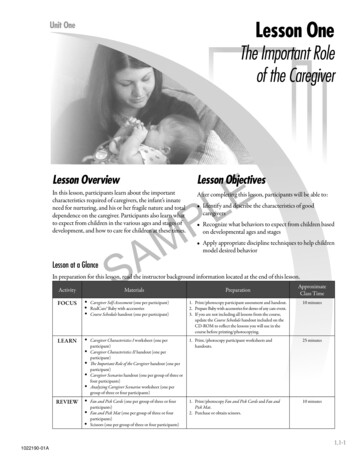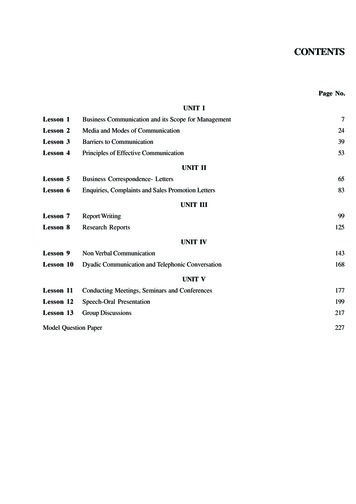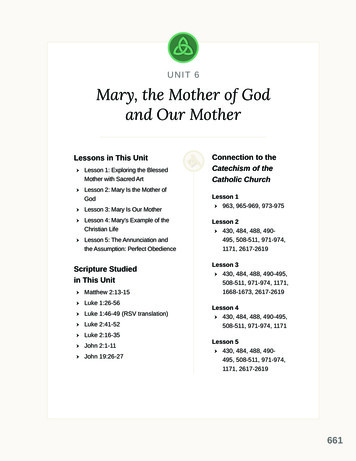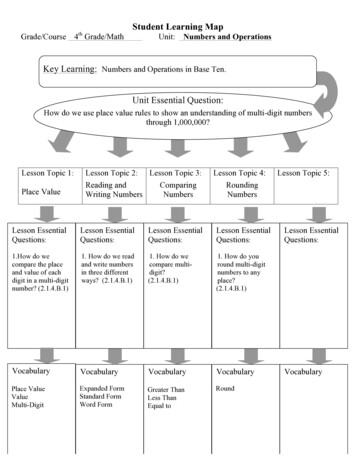
Transcription
Lesson OneUnit OneThe Important Roleof the CaregiverELPLesson OverviewLesson ObjectivesIn this lesson, participants learn about the importantcharacteristics required of caregivers, the infant’s innateneed for nurturing, and his or her fragile nature and totaldependence on the caregiver. Participants also learn whatto expect from children in the various ages and stages ofdevelopment, and how to care for children at these times.Lesson at a GlanceAfter completing this lesson, participants will be able to:MAS Identify and describe the characteristics of goodcaregivers Recognize what behaviors to expect from children basedon developmental ages and stages Apply appropriate discipline techniques to help childrenmodel desired behaviorIn preparation for this lesson, read the instructor background information located at the end of this s TimeFOCUS Caregiver Self-Assessment (one per participant)RealCare Baby with accessoriesCourse Schedule handout (one per participant)1. Print/photocopy participant assessment and handout.2. Prepare Baby with accessories for demo of any care event.3. If you are not including all lessons from the course,update the Course Schedule handout included on theCD-ROM to reflect the lessons you will use in thecourse before printing/photocopying.10 minutesLEARN Caregiver Characteristics I worksheet (one perparticipant)Caregiver Characteristics II handout (one perparticipant)The Important Role of the Caregiver handout (one perparticipant)Caregiver Scenarios handout (one per group of three orfour participants)Analyzing Caregiver Scenarios worksheet (one pergroup of three or four participants)1. Print./photocopy participant worksheets andhandouts.25 minutesFan and Pick Cards (one per group of three or fourparticipants)Fan and Pick Mat (one per group of three or fourparticipants)Scissors (one per group of three or four participants)1. Print/photocopy Fan and Pick Cards and Fan andPick Mat.2. Purchase or obtain scissors.10 minutes REVIEW 1.1-11022190-01A
Basic Infant CareThe Important Role of the CaregiverFOCUS: Caregiver Self-Assessment10 minutesPurpose:Materials:Participants complete a caregiver self-assessment to thinkabout their characteristics and learning needs for thecourse. During this time they listen to RealCare Baby cryand then discuss their reactions to hearing the crying whiletrying to concentrate on something else. Caregiver Self-Assessment RealCare Baby with accessories Course Schedule handoutELPFacilitation Steps:1. Give each participant a photocopy of the Caregiver SelfAssessment.2. As participants begin completing the assessment,program RealCare Baby to demonstrate any care event,altering event duration to 180 seconds (three minutes).Let Baby cry—do not attend to its need. Baby’s cry willintensify as care is not given. After three minutes, Babywill stop crying.feeding, burping, diapering, soothing and comforting,checking to ensure that the infant does not have a fever,is not too hot or cold, and so on. Explain that in thislesson we will be talking about the characteristics goodcaregivers should have.MAS3. Divide participants into groups of four and instructthem to discuss how they felt about the crying whilethey were trying to complete the self-assessment. Didanyone get frustrated, distracted, annoyed, and/or angry? Select a few groups to tell how they felt.4. Ask participants to imagine being unable to walk, crawl,talk, or communicate their needs and wants. How wouldthey feel? The only method of communication an infanthas is crying. Caregivers must empathize with the child,and work to find out what the infant is trying to communicate, first by attending to his or her basic needs:1.1-25. Briefly review some of the questions on the self-assessment. Explain that the purpose was to help them thinkabout their experience in working with children andtheir caregiver skills.6. Give each participant a copy of the Course Schedulehandout and discuss briefly.
Unit One—Lesson OneCaregiverSelf-AssessmentThe Important Role of the CaregiverName:Date:Directions: Answer the following questions by placing an “x” in the appropriate box, writing your response in the spaceprovided, or circling the best answer.1. The youngest child I have cared for was: Infant (newborn to 12 months) Toddler (1 to 3 years) Preschooler (3 to 5 years) School-ager (5 years and older) I have never cared for a child.2. The longest length of time I have cared for a child was: 1 to 4 hours 5 to 8 hours Overnight Days at a time I have never cared for a child.MAELP3. I have cared for up to children at a time.S4. On a scale of 1 to 5, I would rate my skills as the following:Ability to make decisionsPoorAverageExcellent12345Ability to be patient with children12345Ability to communicate with children12345Ability to communicate with parents/guardians12345Ability to attend to an infant’s basic needs12345Ability to have fun with children12345Ability to think quickly in an emergency12345Ability to perform first aid and CPR12345Ability to handle misbehavior12345Understanding of developmental stages123455. The reasons I want to be a caregiver are: 1.1-3
Unit One—Lesson OneThe Important Role of the CaregiverLEARN: Characteristics of a Caregiver25 minutesPurpose:Materials:This activity helps participants learn about the characteristics of a caregiver and why they are important in caringfor children. Participants read caregiver scenarios. In smallgroups, they discuss the scenarios, incorporating thoughtabout the skills and characteristics demonstrated, and howthey would have handled the situation. The groups sharetheir thoughts in a large class discussion. Caregiver Characteristics I worksheet Caregiver Characteristics II handout The Important Role of the Caregiver handout Caregiver Scenarios handout Analyzing Caregiver Scenarios worksheetELPFacilitation Steps:Part 1: Think, Pair, SharePart 2: Caregiver ScenariosMA1. Divide participants into pairs.2. Give each participant a copy of the Caregiver Characteristics I worksheet and ask groups to discuss what theyconsider to be important caregiver characteristics. Afterthree minutes, instruct groups to share their ideas withanother group. Lead a class discussion, asking groups toshare their ideas.S3. Give each participant a copy of the Caregiver Characteristics II handout. Lead a class discussion by asking whythe caregiver characteristics listed on the handout areimportant in caring for an infant or toddler.4. Give each participant a copy of The Important Role ofthe Caregiver handout and discuss briefly. Note anyvalid points that are mentioned. Clarify, elaborate, andadd information as needed during the class discussion.For example, infants cannot think beyond their ownpersonal needs. They are totally dependant on theircaregiver to meet all their needs: physical,intellectual, emotional, and social. They need to feelsecure and need a great deal of attention.1. Divide participants into groups of three or four.2. Give each group a copy of the Caregiver Scenarios handout. Assign one scenario per group.3. Instruct groups to read their scenario and discuss thecharacteristics and skills demonstrated by the caregiveras well as the child’s perspective, if appropriate (i.e., whatis motivating the child’s behavior and how could thecaregiver model the desired behavior?).4. Give each group a copy of the Analyzing CaregiverScenarios worksheet and instruct them to complete itfor the scenario they were given to analyze. Lead a classdiscussion, asking groups to share their observationsabout the scenarios.1.1-7
CaregiverCharacteristics IUnit One—Lesson OneThe Important Role of the CaregiverName:Date:Directions: With your group, brainstorm ideas about what you consider to be important characteristics and skills of acaregiver. As you brainstorm, remember that all ideas should be recorded.ELPMAS1.1-9
CaregiverCharacteristics IICharacteristics important in caring for an infant or toddler:Unit One—Lesson OneThe Important Role of the Caregiver Empathy and nurturingshould also be able to determine whether there is a medicalemergency, and how to respond quickly and appropriately.Communication Skills Decision-making skills Patience Safety and health consciousness Communication skills Ability to handle stress Understanding of child developmental stagesELPEmpathy and NurturingEmpathy is the ability to put oneself in the position ofanother and try to understand how that person is feeling;to have sympathy and compassion for another person.Nurturing involves giving tender care and protection whileshowing love, support, concern, and encouragement.MADecision-Making SkillsCaregivers encounter many different situations with infants and toddlers. Each situation requires that a caregiverbe able to evaluate the situation and determine the bestcourse of action to take:S Identify the problem—what do you need to decide? List the various solutions—what are your choices? Evaluate each solution—consider the positive andnegative outcomes. Choose the best solution.PatienceGood communicators help guide the actions of children ina positive manner. If children misbehave, be sure they understand that you do not dislike them, even though you donot like their behavior. Use positive feedback to reinforcegood behavior such as, “I like how you picked up your toysafter playing with them.” Use corrective feedback to stopor change misbehavior, to tell the child what they shoulddo, or what the appropriate thing to do is, or what youwould like them to do. Corrective feedback uses positiverequests in a respectful manner. For example, “Sally, pleasedraw the picture on your own paper,” rather then saying,“Do not draw on Billy’s paper.”Here are some basic guidelines when communicating withchildren:Be Respectful: When you treat children with respect, youare modeling the behavior you expect from them. They inturn will treat you with respect. Use “please” and “thankyou.” Do not call them names or say they are bad. This canhurt a child’s feelings and does not help a situation.Keep it Simple: Children may have a hard time understanding long instructions or long words. Speak at a levelthat is easy for a child to understand. Keep your sentencesshort and simple.Listen: Look at the child when he or she is talking to you.If possible, bend down so you are at eye level with thechild. If you are not able to do what the child wants or youneed to focus your attention on something else first, let thechild know that you heard his or her request.Infants and toddlers can try your patience. They dawdle,they may refuse to do what you want or need them to do,and they often want to do the same things over and over.Patience is the ability to endure waiting or delay withoutbecoming annoyed or upset; to persevere calmly whenfaced with difficulties.Remain Calm: Even if you are angry or frustrated withan infant or a toddler, use a calm voice and remain calm.If you need to, take a minute for yourself, and take a deepbreath and count to ten.Safety and Health ConsciousnessSometimes children may misbehave. This may be an indication that they need help controlling their behavior andexpressing themselves in a positive way. Remember thatan infant is not capable of misbehaving. However, when atoddler, preschooler, or school-ager misbehaves, you havethree courses of action you can take:Caregivers must be continually alert to ensure that thereare no safety hazards near an infant or toddler, and thatchildren are not engaging in dangerous activities. Caregivers must know how to perform basic first aid and infantand toddler CPR (cardiopulmonary resuscitation). TheyAbility to Handle Stress1.1-11
Basic Infant CareThe Important Role of the Caregiver You can ignore it. You can say something to correct the child and changethe behavior, telling the child what you would like himor her to do instead. You can physically take control of the situation. Thisis reserved for situations in which the child is doingsomething that is a threat to themselves or to others.For example, if a child is hitting or biting another child,you should gently grasp the child’s arm and tell him orher that he or she is not allowed to do that. If the childappears to be angry, ask why he or she is angry and talkthe situation through. If the child is about to throw anobject at someone, take the object away.As the caregiver, you need to decide which course of actionis most appropriate, and then take it. Remind the childthat it is the behavior, not the child that you do not like.Children need to know that you will not stop liking themif they misbehave. Use positive feedback to help guidechildren before they misbehave, and make positive andrespectful requests when they misbehave. Modeling respecthelps children see how they should behave with you andwith each other. Never make fun of, hit, spank, shake, orshout at a child, no matter how frustrated you becomewith their behavior.MAELPSUnderstanding of Child Developmental StagesAll infants and toddlers pass through standard stages ofdevelopment at specific ages. However, because all infantsand toddlers are different, they may not be at the samedevelopmental level as others, even though they are thesame age. Some children progress more quickly, othersmore slowly. Caregivers need to understand the stages ofdevelopment and the abilities of the children in their care.1.1-12
The Important Roleof the CaregiverUnit One—Lesson OneThe Important Role of the CaregiverCaregivers attend to the needs of children at preschools, nursery schools, businesses, daycare centers, and in private homes. In these settings, it generally involves the nurturingand teaching of children ages five and younger, but may also include school-aged childrenwho come before and after the school day and/or during the summer. In addition to ensuring the safety and well-being of a child, a good caregiver attends to the emotional, intellectual, and creative needs of children. Caregivers should be enthusiastic and involved as theyorganize stimulating and interesting activities, manage creative play times, and supervise interaction with other children. Caregivers must also know how to communicate with infantsand toddlers at their level of understanding in a nurturing and positive way.ELPCaregivers must keep records of each child’s progress including daily observations and information about activities, meals served, and medications administered, and discuss the child’sdevelopment and needs with the parents, who often feel left out of their children’s day-today lives. They instruct children in health and personal habits such as eating, resting, andtoilet habits, and identify signs of emotional or developmental problems in children andbring them to parents’ or guardians’ attention.MASBeing a caregiver is physically and emotionally draining. The caregiver will find that he orshe is continually bending down, picking up, standing, lifting, or carrying small children. Infants and toddlers may cry or scream for little reason, they have little or no control over theirbodily functions, and they require a great deal of attention and nurturing. Even with thesedrawbacks, people who work with children do so because they love them and enjoy being animportant part of their physical, intellectual, emotional, and social development. The earlychildhood years are the most crucial in a person’s intellectual and emotional development,and often shape a child’s first memories. Caregivers see the importance of this role and havea strong desire to be a part of that special time in every person’s life.1.1-13
Caregiver ScenariosUnit One—Lesson OneThe Important Role of the CaregiverScenario 1David is two years old and is starting his first day at Aria’sday care center. As David approaches with his father, Ariagreets them and stoops down to look David in the eyes.She smiles and tells him her name.As David’s father leaves, Aria shows David around theroom and explains the rules of behavior. She introducesDavid to the other two-year-old children and asks him tochoose a toy he would like to play with until snack time.David chooses a toy that another toddler is playing withand he grabs it from him. Aria scolds David in a loud voiceand tells him to apologize to the other child.take other children’s snacks or food at any time. She tellsRachel that it is important to not take other people’s food.Rachel replies that she is hungry. Patricia explains that ifRachel is still hungry after her snack, she should let Patriciaknow, so Patricia can give her some more.ELPDavid begins to cry. She comforts him and asks him whatis wrong. He is crying too hard to answer, so she sits himdown in a chair and tells him he can play when he is readystop crying and start acting nice.MAScenario 2Aaron is six weeks old and is being cared for by his aunt,Marion, while his mother works three days per week.Aaron gets fussy around 3:00 p.m. and tends to cry nonstop until his mother picks him up after work. Aaron spitsup quite a bit when he is fed. Marion makes a note to mention this to Aaron’s mother; it could be a problem withacid reflux.SToday, Marion has noticed that Aaron refuses to take thebottle and cries more than usual. She checks to make surehe is dry and that he does not have a fever. She tries to gethim to look at a mobile in his crib and she holds a mirrorto his face, hoping to distract him, but neither of these isworking. Aaron continues to cry. In frustration, Mariongoes into the other room to wait for him to stop crying.Scenario 3Rachel is three years old and loves to play with her caregiver, Patricia. Patricia is the day care provider for eightchildren. Rachel likes to follow Patricia around and helpher take care of the infants in Patricia’s care. Rachel tendsbe whiny around the other children. She gets angry easily ifshe does not get her way.One day Patricia notices that Rachel has been taking thesnacks away from the little girl she sits next to during snacktime. Patricia explains to Rachel that she is not allowed toLater that day, Patricia sees that Rachel is angry over a toythat someone else has and that she wants. Patricia asksRachel why she is angry. Rachel explains that she wanted toplay with that toy. Patricia responds by saying that she understands what it is like to want something that someoneelse has, but that Rachel needs to be patient and she canhave a turn with the toy later. She gets Rachel interested inanother activity.Scenario 4Jordan is caring for three children at the home of hisneighbors: Nick (18 months), Carl (three years old), andJessica (six years old). Jordan has decided that going to thepark down the street would be a good way to spend theafternoon. Jordan announces the plan right after lunch. Hetells Carl and Jessica to get their shoes and jackets on whilehe changes Nick’s diaper and gets him ready to be put intothe stroller.Carl is tired after lunch and wants to stay home and watchTV. Jordan tells him it’s time to get going and he can watchTV later. After Jordan changes Nick’s diaper and has himready to go, he notices that Carl is still putting on his shoes.Carl is just learning how to put on his shoes and wants toshow Jordan. Jordan tells Carl that they do not have timefor that. He puts Carl’s shoes on for him. Carl becomesangry, begins to cry, and pulls off his shoes. Jordan becomesangry and tells Carl that if he does not keep his shoes on,he cannot come to the park. Carl is glad to be able to stayhome and watch TV, not fully understanding that he willbe left alone and might become afraid.Jordan puts Carl in front of the TV to watch a half-hourshow, and decides that he will take Nick and Jessica down acouple of houses and then check back to see if Carl changeshis mind while they are gone. In the mean time, the children’s mother calls and Carl answers the phone. She is veryconcerned that Jordan has left Carl alone while he broughtthe others to the park.1.1-15
Basic Infant CareThe Important Role of the CaregiverScenario 5Juan is six months old and goes to a day care program eachday. Juan is a good-natured infant and very easy to care for.When Juan’s mother comes to pick him up from day care,she asks how Juan did. The provider explains that Juanslept most of the day in a swinging crib. She seems verypleased at how easy Juan is to care for. As Juan’s mothergets home, she notices that Juan’s head is beginning to getflat in the back. She realizes that Juan is spending most ofthe day sleeping, and this may explain the sleepless nightshe has been having since beginning at day care.MAELPS1.1-16
Analyzing CaregiverScenariosUnit One—Lesson OneThe Important Role of the CaregiverName:Date:Directions: Read your scenarios with your group and discuss and respond to each of the questions below. Be prepared toshare your scenarios and responses with the large group.Decision-Making SkillsCaregiver StressDid the caregiver:Did the caregiver:Identify the problem?Acknowledge his or her frustration level?Determine choices for a solution?Take steps to handle his or her stress?Decide on the best solution?ELPCommunication Skills with the ChildDid the caregiver:Did the caregiver:Keep rules and instructions simple and clear?MABe specific about what he or she was saying?Acknowledge the child’s feelings?Show the child respect?Use a calm voice?SListen to the child and respond?Helping Children BehaveDid the caregiver:Communication Skills with the Parent(s)Accurately communicate the situation?Encourage two-way communication?Handling Stress with an InfantDid the caregiver:Use techniques for soothing?Use techniques for handling stress?How would you have handled the situation differently?Consider the child’s developmental stage?Give positive feedback when the child behaved?Give positive correction when the childmisbehaved?Take one of the three courses of action when thechild misbehaved?1. Ignore it?2. Say something to correct the child?3. Physically take control of the situation?1.1-17
Unit One—Lesson OneThe Important Role of the CaregiverREVIEW: Fan and Pick Game10 minutesPurpose:Materials:The purpose of this activity is to review the main pointsfrom the lesson and to give participants an opportunity tothink about what they learned. Fan and Pick Cards Fan and Pick Mat ScissorsFacilitation Steps:ELP1. Divide participants into groups of four.2. Give each group a copy of Fan and Pick Cards and Fanand Pick Mat.3. Give each group a pair of scissors and instruct them tocut apart the cards.MA4. Instruct groups to take turns playing the four rolesshown on the mat:S Fan: Participant who fans out the cards for the nextparticipant to choose from. Answer: Participant who answers the question. Check and Praise: Participant who responds to theanswer with praise for correct answer, correctionfor an incorrect answer, or simply acknowledges theanswer given.5. Explain that roles rotate by turning the mat clockwise after each turn, rotating four times so that each participanthas an opportunity to play each role. Circulate the roomand offer assistance and answer questions as necessary. Pick and Read Question: Participant who choosesone card and reads the question aloud.1.1-19
Fan and Pick CardsELPDescribe a time in yourchildhood when a caregivershowed empathy.MASThe Important Role of the CaregiverIdentify two places wherecaregivers attend to theneeds of children.Name three importantcharacteristics of caregivers.Explain why infants requirelove, but cannot give love.Unit One—Lesson OneWhat did you learn ordiscover while completingthe scenario activity?Why do you want tobe a caregiver?Why is patience an importantpart of care giving?What does it meanto be nurturing?What are some negativethings you learned NOT to doin today’s lesson?What are some positivethings you learned to doin today’s lesson?1.1-21
Fan & Pick MatUnit One—Lesson OneThe Important Role of the CaregiverPick & ReadQuestionFanELFan &PPickMASCheck &PraiseAnswer1.1-23
Unit One—Lesson OneThe Important Role of the CaregiverInstructor Background InformationCaregivers attend to the needs of children atpreschools, nursery schools, businesses, day care centers, and in private homes. In these settings, it generallyinvolves the nurturing and teaching of children ages fiveand younger, but may also include school-aged childrenwho come before and after the school day and during thesummer. In addition to ensuring the safety and well-beingof a child, a good caregiver attends to the emotional, intellectual, and creative needs of children. Caregivers shouldbe enthusiastic and involved as they organize stimulatingand interesting activities, manage creative play times, andsupervise interaction with other children. Caregivers mustalso know how to communicate with infants and toddlersat their level of understanding in a nurturing and positiveway.ELPCaregivers must keep records of each child’s progressincluding daily observations and information about activities, meals served, and medications administered; anddiscuss the child’s development and needs with the parents,who often feel left out of their children’s day-to-day lives.They instruct children in health and personal habits suchas eating, resting, and toilet habits, and identify signs ofemotional or developmental problems in children andbring them to parents’ or guardians’ attention.SMABeing a caregiver is physically and emotionally draining.The caregiver will find that he or she is continually bending down, picking up, standing, lifting, or carrying smallchildren. Infants and toddlers may cry or scream for littlereason, they have little or no control over their bodily functions, and they require a great deal of attention and nurturing. Even with these drawbacks, people who work withchildren do so because they love them and enjoy being animportant part of their physical, intellectual, emotional,and social development. The early childhood years are themost crucial in a person’s intellectual and emotional development, and often shape a child’s first memories. Caregivers see the importance of this role and have a strong desireto be a part of that special time in every person’s life.1.1-25
Basic Infant CareThe Important Role of the CaregiverAdditional ResourcesU.S. National Health Education Standards Supported3.8.4, 3.12.4; 5.8.2; 7.8.2-3, 7.12.2-3Publications:Butler, S., & Kratz, D. (1999). The field guide to parenting:A comprehensive handbook of great ideas, advice, and solutions for parenting children ages one to five. Worcester, MA:Chandler House Press.U.S. National Standards for Family and Consumer SciencesEducation Supported4.1, 4.1.1; 15.2, 15.2.1Hilliard, J., & Rothenberg, B. (1995). Parentmaking: Apractical handbook for teaching parent classes about babiesand toddlers. Menlo Park, CA: Banster Press.Organizations and Web Sites:Family ww.babygooroo.comBabyCenterwww.babycenter.comZero To Threewww.zerotothree.orgMAUniversity of Minnesota Extensionwww.extension.umn.edu/FamilyLove and Logicwww.loveandlogic.com1.1-26S
Lesson at a Glance In preparation for this lesson, read the instructor background information located at the end of this lesson. Activity Materials Preparation Approximate Class Time FOCUS CavereAgi r - Sssesslfe ment (one per participant) RealCare Baby with accessories Course Schedule handout (one per participant) 1.










